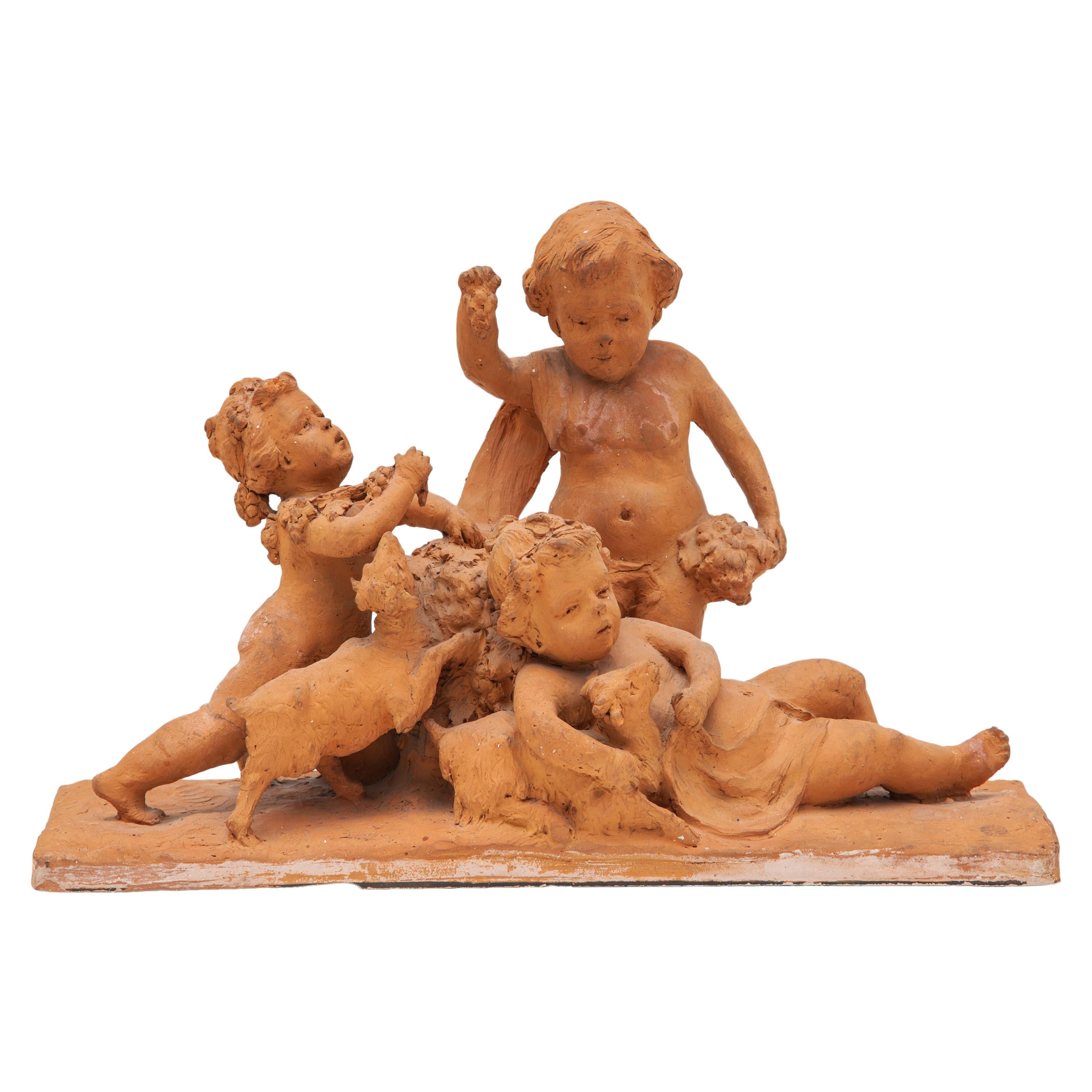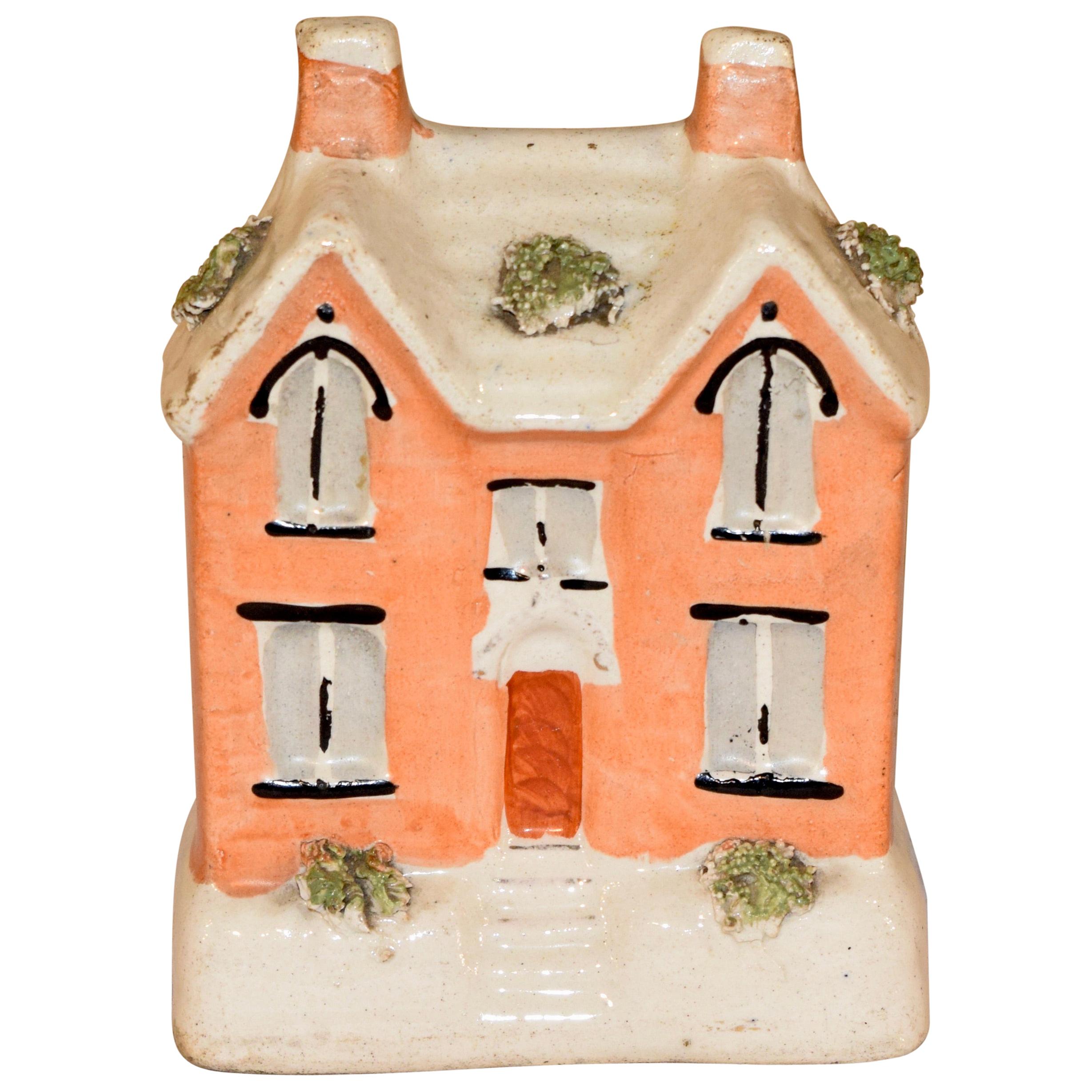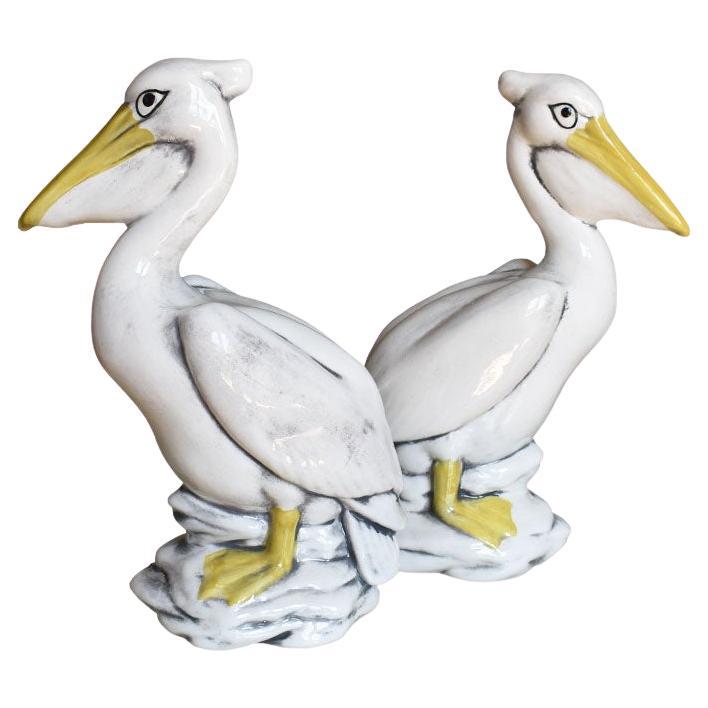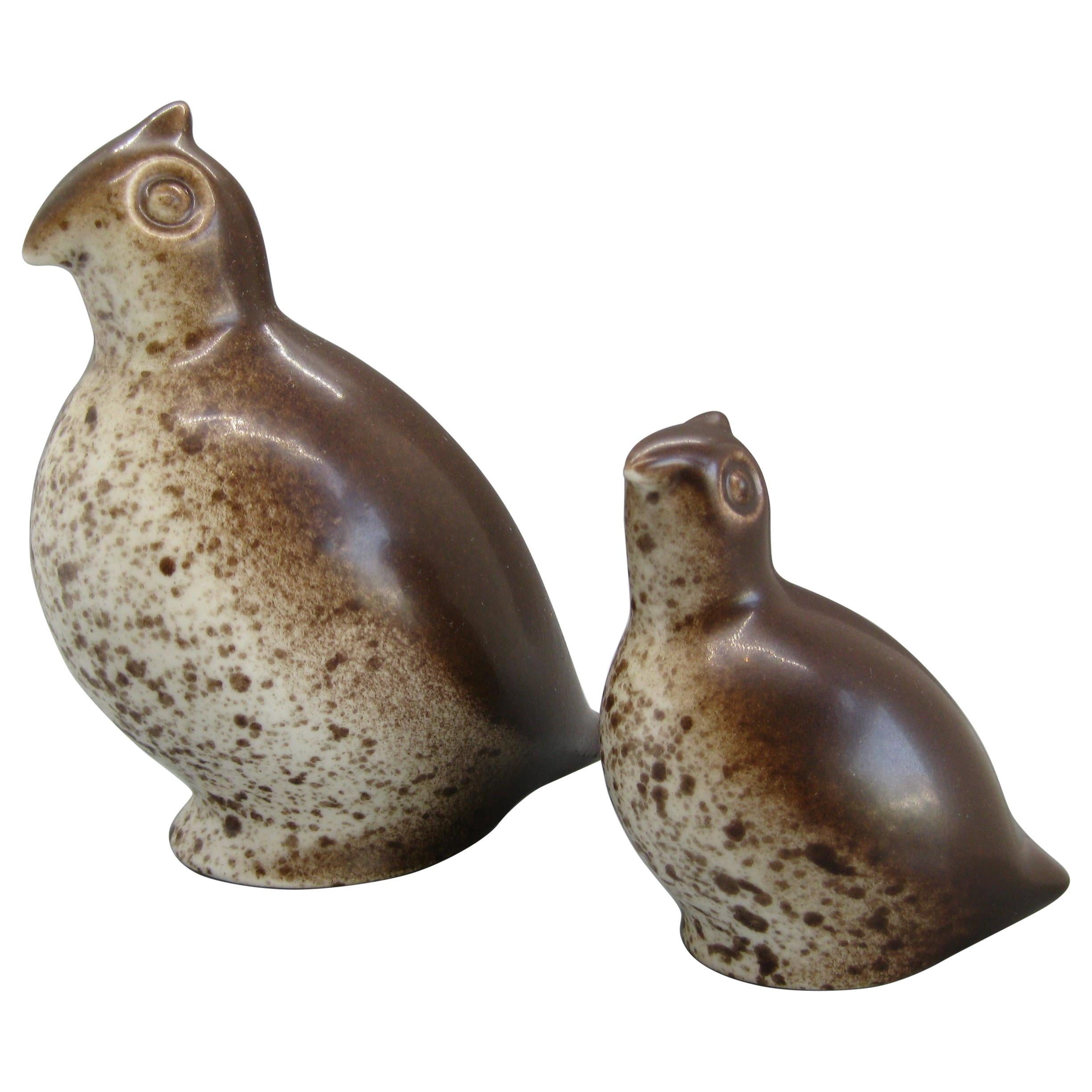Items Similar to Charming Pair of Austrian 19th Century Polychromed Majolica Wall Sculptures
Want more images or videos?
Request additional images or videos from the seller
1 of 10
Charming Pair of Austrian 19th Century Polychromed Majolica Wall Sculptures
About the Item
A fine and charming pair of Austrian 19th century polychromed majolica hanging wall sculptures of an elderly couple peeking through a window, probably by Friedrich Goldscheider (Goldscheider'sche Porzellan-Manufactur und Majolica-Fabrik.) Each wall sculpture depicting an elderly man wearing glasses and a traditional cap with his arms extended forward as if it was reading a book or a newspaper. The other depicting an elderly lady, also peeking through a window, wearing a laced cap with a bow tie and shawl over her shoulders, her arms are also extended forward as if it was reading a book or a newspaper. The male figure stamped on the back "78 - II ." The lady figure stamped on the back "37 - 79." Vienna, circa 1890-1900.
Man's height: 16 1/2 inches (41.9 cm.)
Man's width: 13 3/4 inches (34.9 cm.)
Depth: 8 1/2 inches (21.6 cm.)
Lady's height: 15 1/2 inches (39.4 cm.)
Lady's width: 13 3/4 inches (34.9 cm.)
Lady's depth: 6 1/2 inches (16.5 cm.)
Goldscheider Manufactory and Majolica Factory (German: Goldscheider'sche Porzellan-Manufactur und Majolica-Fabrik, (now) Goldscheider Keramik) is an Austrian ceramic manufactory.
In 1885, Friedrich Goldscheider came from the small Bohemian city of Pilsen to Vienna and founded the Goldscheider Manufactory and Majolica Factory. It became one of the most influential ceramic manufactories of terracotta, faience and bronze objects in Austria with subsidiaries in Paris, Leipzig and Florence. For over half a century Goldscheider created masterpieces of historical revivalism, Art Nouveau (Jugendstil) and Art Deco. Famous artists such as Josef Lorenzl, Stefan Dakon, Ida Meisinger and the two perhaps best known Austrian ceramic artists Michael Powolny and Vally Wieselthier worked for Goldscheider. Several of the artists who worked for Goldscheider also worked for other Viennese studios, such as Augarten, Keramos or for the German brands Rosenthal and Meissen.
The Goldscheider family emigrated in 1938 to United Kingdom and USA. Walter Goldscheider startet a new factory in Trenton, New Jersey and returned to Vienna in 1950. Marcel Goldscheider went to Stoke-on-Trent and produced figurative ceramics for Myott and opened his own studio in the 1950s in Hanley. Both brothers died in the early 1960s.
More than 10,000 different models were created over a period of three generations. Since the very beginning many of these won first prizes and gold medals at innumerable world fairs, exhibitions and trade fairs. Goldscheider figures are nowadays very much sought after by collectors worldwide and reach astonishing prices at auctions such as Sotheby's, Christie's, Dorotheum and on ebay.
Several exhibitions and lectures took place since the new book on Goldscheider was presented in 2007 to the public: a big Goldscheider exhibition was shown at the Vienna Museum (November 2007 – February 2008), at the LBI in New York (Jan. – Apr. 2009) as well as lectures in Prague at the Museum of Decorative arts (June 2008) and at the 10th Worldwide Art Deco Congress in Montreal (May 2009). From June till October 2015 the Grassi Museum honoured the history of Goldscheider in Leipzig with an amazing exhibition. Current exhibitions are usually shown at the official Goldscheider website.
- Attributed to:Friedrich Goldscheider (Manufacturer)
- Dimensions:Height: 16.5 in (41.91 cm)Width: 13.75 in (34.93 cm)Depth: 8.5 in (21.59 cm)
- Sold As:Set of 2
- Style:Baroque (In the Style Of)
- Materials and Techniques:Majolica,Polychromed
- Place of Origin:
- Period:
- Date of Manufacture:circa 1890-1900
- Condition:Wear consistent with age and use. Good antique condition with minor wear and old paint chippings (see images). Unlike others similar, these pair is one of the earliest and finest majolica sculptures with fine attention to detail.
- Seller Location:Los Angeles, CA
- Reference Number:
About the Seller
5.0
Vetted Seller
These experienced sellers undergo a comprehensive evaluation by our team of in-house experts.
Established in 1982
1stDibs seller since 2016
114 sales on 1stDibs
Typical response time: <1 hour
- ShippingRetrieving quote...Ships From: Los Angeles, CA
- Return PolicyThis item cannot be returned.
More From This SellerView All
- Charming Italian 19th-20th Century Carved Alabaster Figure of a Fisher BoyLocated in Los Angeles, CAA charming Italian 19th-20th century carved alabaster figure of a fisher boy. The young boy wearing a blouse, with his pant legs rolled up to his knees and ...Category
Antique Early 1900s Italian Country Figurative Sculptures
MaterialsAlabaster
- French 19th-20th Century Art Nouveau Polychromed Terracotta Bust of "Crépuscule"By Salesio LugliLocated in Los Angeles, CAA fine French 19th-20th century Art Nouveau polychromed terracotta bust of "Crépuscule" (Twilight) After Henri Jacobs (Belgian, 1864-1935) version of Crépuscule, depicting a young ma...Category
Antique Early 1900s French Art Nouveau Busts
MaterialsTerracotta
- Pair 19th-20th Century Majolica Busts of "the Banjo Player and the Flower Lady"By GOLDSCHEIDERSCHE PORZELLAN-MANUFACTUR UND MAJOLICA-FABRIK (1885-1953)Located in Los Angeles, CAA very fine and rare pair of 19th-20th century Majolica busts of "The Banjo Player and The Flower Lady," probably Austrian Goldscheider, each depicting an ...Category
Antique Early 1900s Austrian Other Busts
MaterialsTerracotta
- French 19th Century Polychromed Life-Size Figure of a Geisha, Charles MasséBy Charles MasseLocated in Los Angeles, CAA fine French 19th century Polychromed Japonisme life-size cast-metal figure of a standing Geisha, cast after a model by Charles Massé (French, 1855-1913). The standing Japanese beau...Category
Antique 19th Century French Japonisme Figurative Sculptures
MaterialsMetal
- Pair French 19th/20th Century Gilt-Bronze Sculptures of The Marly Horses LampsBy Guillaume CoustouLocated in Los Angeles, CAA Fine Pair of French 19th/20th Century Gilt-Bronze Sculptures of "The Marly Horses" (Now turned into lamps) After the original by Guillaume Coustou (French, 1677-1746). The large pair of equestrian bronze sculptures, finished in a gold patina, each depicting rearing horses with their groom, both raised on oval a black slate and Bardiglio marble bases and fitted with modern electrical twin-light brass fittings and cream colored shades. The base on an ebonized wooden platform. Circa: Paris, 1900-1920. Sculpture & Base Height: 31 1/4 inches (79.8 cm) Base Width: 21 3/4 inches (55.3 cm) Base Depth: 12 3/4 inches (32.4 cm) Height to top of (Adjustable) shade fitting: 48 1/4 inches (122.6 cm) Shade Height: 15 inches (38.1 cm) Shade Width: 26 inches (66.1 cm) Shade Depth: 20 inches (50.8 cm) The original Marly Horses are two 1743–1745 Carrara marble sculpted groups by Guillaume Coustou. They were commissioned by Louis XV of France for the trough at the entrance to the grounds of his château de Marly. Coustou's last works, they were intended to replace two other sculpted groups, Mercury on Pegasus and Pegasus, Renown of Horses, both by Antoine Coysevox, which had been removed to the Tuileries Gardens in 1719. Louis XV chose the modellos in 1743 and the full-size sculptures were completed in only two years, being installed at Marly in 1745. They proved highly successful in reproduction, particularly on a smaller scale, and prefigured Théodore Géricault and other Romantic artists' obsession with equestrian subjects. The Marly horses were later also used as the central motif of the monochrome 819-line RTF/ORTF test card which was used on TF1 from 1953 until 1983. The originals were moved to the place de la Concorde in Paris in 1794 and Louis-Denis Caillouette (1790–1868) restored them in 1840. In 1984 it was concluded that the annual military parades on 14 July were damaging the sculptures and they were replaced by marble copies produced by Michel Bourbon in the studio of a subsidiary of Bouygues. The latter also gained the right to an extra copy, which was placed in Bouygues's social building. The original sculptures were moved to a former courtyard in the Richelieu wing of the Louvre Museum, which was renamed the 'cour Marly' in their honour, whilst Bourbon's two main copies were moved to the originals' first site near the trough at Marly, with work overseen by the architect Serge Macel. Guillaume Coustou the Elder (29 November 1677, Lyon – 22 February 1746, Paris) was a French sculptor of the Baroque and Louis XIV style. He was a royal sculptor for Louis XIV and Louis XV and became Director of the Royal Academy of Painting and Sculpture in 1735. He is best known for his monumental statues of horses made for the Chateau of Marly, whose replicas now stand in the Place de la Concorde in Paris. Coustou was a member of a family of famous sculptors; his uncle, Antoine Coysevox, was a royal sculptor; his elder brother, Nicolas Coustou was a sculptor, and his son Guillaume Coustou the Younger also become a noted royal sculptor. Like his older brother, he won the (Prix de Rome) of the Royal Academy which entitled him to study for four years at the French Academy in Rome. However, he refused to accept the discipline of the academy, gave up his studies, set out to make his own career as an artist. He worked for a time in the atelier of the painter Pierre Legros, and eventually returned to Paris. Upon his return to Paris, he assisted his uncle Coysevox in making two monumental equestrian sculptures, Fame and Mercury, for the Château de Marly, the new residence of Louis XIV near the Palace of Versailles, where he went to escape the crowds and ceremony of the Palace. He later (1740–1745), made his own horses, The Horses of Marly, his most famous works, to replace them. The horses reinvent the theme of the colossal Roman marbles of the Horse Tamers in the Piazza Quirinale, Rome. They were commissioned by Louis XV in 1739 and installed in 1745 at the Abreuvoir ("Horse Trough") at Marly. The horses were considered masterpieces of the grace and expressiveness of the French Late Baroque or Rococo style. After the Revolution they were moved from Marly to the beginning of the Champs-Élysées on the Place de la Concorde. The originals were brought indoors for protection at the Louvre Museum in 1984. In 1704 Coustou was received into the Académie royale de peinture et de sculpture. The work he made to mark his entrance was Hercules on the Pyre, now in the Louvre. It displays the special hallmark of the Baroque, a twisting and rising transverse pose, as well as highly skillful carving. He rose to become Director of the academy in 1733. Another of his major works from his later career, the statue of Maria Leszczynska, (1731)is on display at the Louvre. Coustou also created two colossal monuments, The Ocean and the Mediterranean among other sculptures for the park at Marly; the bronze Rhone, which formed part of the statue of Louis XIV at Lyons, and the sculptures at the entrance of the Hôtel des Invalides. Of these latter, the bas-relief representing Louis XIV mounted and accompanied by Justice and Prudence was destroyed during the Revolution, but was restored in 1815 by Pierre Cartellier from Coustou's model; the bronze figures of Mars and Minerva (1733–34), on either side of the doorway, were not interfered with. In 1714 for Marly he collaborated in two marble sculptures representing Apollo Chasing Daphne (both at the Louvre), in which Nicolas Coustou sculpted the Apollo and Guillaume the Daphne. About the same time he was commissioned to produce another running figure in marble, a Hippomenes designed to complement an Atalanta copied from the Antique by Pierre Lepautre...Category
Antique Early 1900s French Louis XV Animal Sculptures
MaterialsMarble, Bronze
- Charming Italian 19th Century Carved Marble Group "Playful Putti with Goat"Located in Los Angeles, CAA very fine and charming Italian 19th century carved Carrara Marble Group "Playful Putti with Goat" depicting two young children, one riding the goat whose two front legs are in the ...Category
Antique 19th Century Italian Rococo Figurative Sculptures
MaterialsCarrara Marble
You May Also Like
- Delft Polychrome Enameled Earthenware Parrot, 18th-19th CenturyLocated in Amsterdam, NLA fabulous polychrome enameled earthenware parrot Delft or France, 18th or 19th century Suspended from a ring, with modern powder-coated stand. Measure: L parrot 26 cm.Category
Antique 19th Century Dutch Ceramics
MaterialsEarthenware
- Ceramic Sculpture with a Group of Playing Putti's 19th Century BelgiumLocated in Antwerp, BEBeautiful in detail and charming 19th century unglazed terracotta sculpture. Features a design of three cherubic children with lamps and fruit, playing with two goats on the base of ...Category
Antique 1890s Belgian Folk Art Figurative Sculptures
MaterialsTerracotta
- 19th Century Large Staffordshire CottageLocated in High Point, NC19th century large Staffordshire cottage with very interesting design. It has many levels and interesting architectural details, accented with h...Category
Antique 19th Century English Victorian Figurative Sculptures
MaterialsCeramic
- 19th Century Staffordshire Cottage BankLocated in High Point, NC19th century Staffordshire pottery penny bank from England in the form of a cottage with flocked details. The coin slot has a few nicks from age and use.Category
Antique 19th Century English Victorian Ceramics
MaterialsPottery
- Pair of Majolica Ceramic Pelican Birds in Yellow Cream and Black, a PairLocated in Oklahoma City, OKA pair of tall handmade hand-painted ceramic majolica pelican birds. Each bird is glazed in cream, yellow and black. This pair will be fabulous to display on a bookshelf or foyer tab...Category
20th Century American Hollywood Regency Animal Sculptures
MaterialsCeramic, Paint
- 19th Century Polychrome Sculpture of a Roman WomanLocated in Haddonfield, NJItalian original painted plaster sculpture of a young Roman woman in nice gilt dress and flower wreath. This well sculptured smiling lady cou...Category
Antique 1880s Italian Neoclassical Animal Sculptures
MaterialsPlaster
Recently Viewed
View AllMore Ways To Browse
Antique Wall Sculpture
Antique Wall Sculptures
Sculpture Of A Man Wall
Sculpture Wall Art Pair
Wall Sculpture Art Pair
Majolica Pair
Pair Of Majolica
Bow Back 19th
Small Majolica
Tie Backs 19th
19th Century Austrian Art Nouveau
Baroque Austria
Lady And Man
Man Wall Sculpture
Antique Furniture New Jersey
New Jersey Antique Furniture
Wall Hanging Man
Austrian Baroque Furniture





